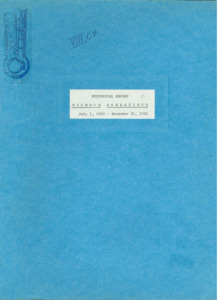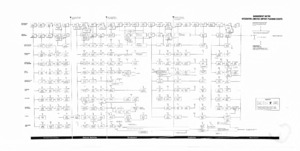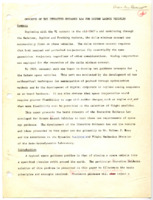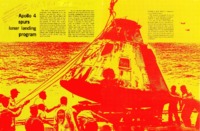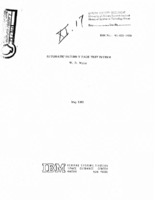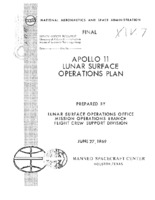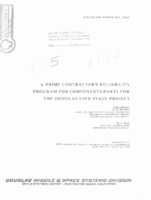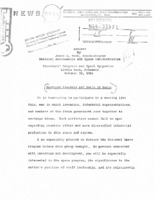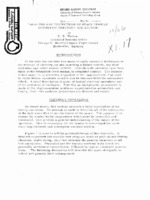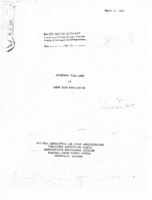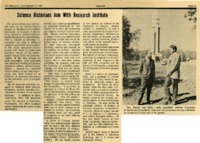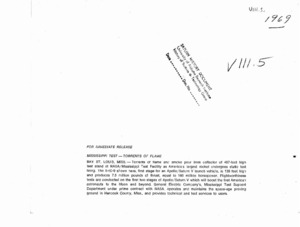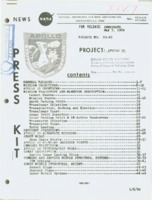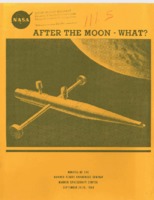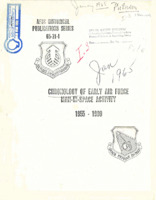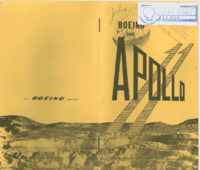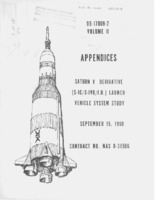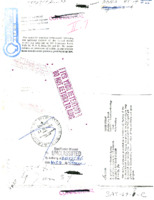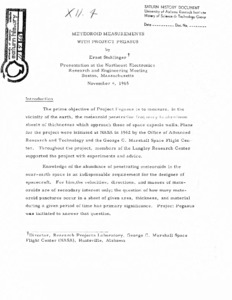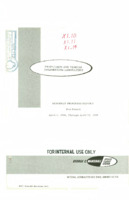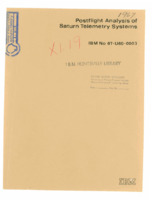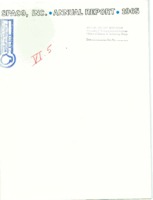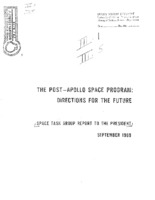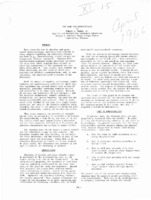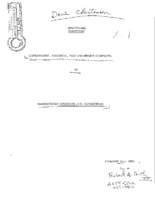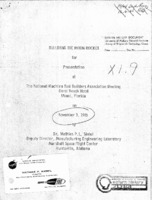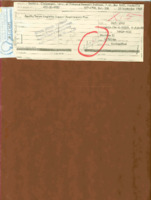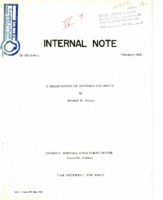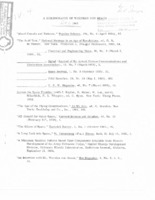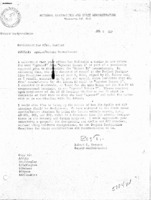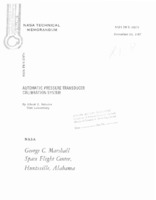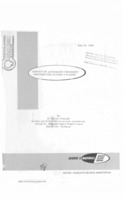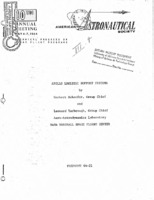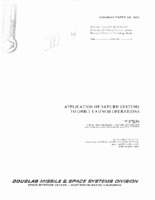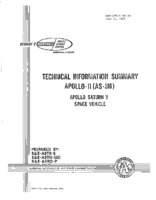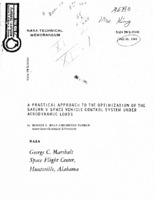
Browse Items (204 total)
Sort by:
-
"Michoud operations : historical operations: July 1, 1963 - December 31, 1963."
Historical report from July 1st to December 31st. -
"Management matrix integrating logistics support planning events."
This was found folded inside Configuration Management. Taken from Defense Industry Bulletin, June 1968. Includes an organizational chart and an accompanying bibliography. -
Draft of "Concepts of the Iterative Guidance Law for Saturn Launch Vehicles."
The summary notes, "In 1960, research work was begun to develop new guidance concepts for the Saturn space vehicles. [...] This paper presents the basics of the Iterative Guidance Law developed for Saturn launch vehicles to meet these new requirements of space age guidance. The development of the Iterative Guidance Law and the results and ideas presented in this paper are due primarily to Mr. Helmut J. Horn and his associates in the Dynamics Analysis and Flight Mechanics Division of the Aero-Astrodynamics Laboratory." Marked "Research Review, OK" in the upper right corner of the first page. The document includes corrections and additions to the text in red pencil. -
Bibliography of RIFT documentation, 1968.
This bibliography appears to be an excerpt of a larger publication. The scan is very poor. -
"Automatic Saturn V Page Test System."
The abstract notes, "This paper describes the Automatic Saturn V Page Test System. The system is used to evaluate microminiature Unit Logic Device (ULD) circuits. A page is an assembly consisting of a magnesium- lithium frame, an input-output connector, test points, and multilateral printed circuit boards that interconnect the IUDs into logic circuits. The test system automatically performs tests for shorted voltages and shorted diodes, static logic function, and pulse function." -
Final Apollo 11 Lunar Surface Operations Plan.
Prepared by the Lunar Surface Operations Office, Mission Operations Branch, Flight Crew Support Division. -
"A Prime Contractor's Reliability Program for Components/Parts for the Douglas S-IVB Stage Project."
This paper, presented at the fifth annual Reliability and Maintainability Conference in New York City, contains a "prime contractor's reliability program for components/parts for the Douglas S-IVB stage project." These parts include special flight critical items and their complementary reliability engineering program plan is outlined in this paper. -
"American Progress and Goals in Space," address by James E. Webb.
This address was given by James E. Webb, Administrator, National Aeronautics and Space Administration, at the Inventors' Congress and Space Symposium, Little Rock, Arkansas. -
"Alignment Tool Aids in Large Tank Fabrication."
Includes the clipping "Clamping Tool Aligns Odd-Shaped Sections for Welding" from <i>Design News</i>, September 4, 1963, written by Margaret A. Maas. -
"Science Historians Join With Research Institute."
Clipping from the UAH Exponent, Wednesday, December 10, 1969, vol. 2, no. 10, page 3. The article highlights the work of Barton C. Hacker and John S. Beltz to collect historical documents from the Saturn program. The documentation they collected is available at UAH Archives and Special Collections in the Saturn V Collection. -
Apollo 5 press kit.
For release Thursday P.M., January 11, 1968. -
"Mississippi test - torrents of flame."
Description of a photograph of a rocket static test firing. -
"Apollo 6 Pre-Launch Press Conference."
The press conference was given at Cape Royal News Center in Cocoa Beach, Florida, on Wednesday, April 3, 1968, at 3:30 PM. Participants: William C. Schneider, Apollo Mission Director, NASA; George M. Low, Apollo Spacecraft Manager, NASA; Clifford Charlesworth, Apollo 6 Flight Director, Manned Spacecraft Center, NASA; Dr. Arthur Rudolph, Saturn V Program Office, Marshall Space Flight Center, NASA; Rocco A. Petrone, Apollo 6 Launch Director, Kennedy Space Center, NASA; Col. Royce Olson, USAF, Director DOD Manned Spaceflight Support Office, Patrick AFB; Chris Kraft, Director of Flight Operations, Manned Spacecraft Center. -
Apollo 10 press kit.
The press kit includes documentation on the Command and Service Module, Lunar Module, Saturn V launch vehicle, astronauts, and mission descriptions. Release No. 69-68. -
"After the Moon - What? Minutes of the Manned Flight Awareness Seminar."
The seminar was held at the Manned Spacecraft Center, September 25-26, 1969. -
"Chronology of early Air Force man-in-space activity: 1955 - 1960."
The foreword states "In this chronology, Air Force manned space flight activity is viewed from the perspective of the ballistic missile development agency - the Air Research and Development Command's Western Development Division, later re-named the Air Force Ballistic Missile Division. Due to resource limitations at the Space Systems Division historical office, research for this chronology has been generally limited to materials available in the files of that office. All documents cite in the notes which follow each entry are located in the archives of the Historical Division, Office of Information, Space Systems Division, in Los Angeles California." There are handwritten notes throughout. -
"Automated PCM Data Processor Theory of Operation."
Includes a blueprint of DDAS System Block Diagram. -
Boeing and Apollo 11.
The phamplet is address to members of the press who are at Cape Kennedy for the Apollo 11 launch. The pamphlet provides information on Boeing's contribution to the Apollo mission. -
Volume II Appendices for the Saturn V Derivative Launch Vehicle System Study.
According to the table of contents, this volume of appendices contain various charts, graphs, and diagrams related to the S-IC stage data, instrument unit data, and vehicle data. -
"Army Participation in the National Satellite and Space Program."
This paper, which was presented at a Semi-Annual Meeting of the American Rocket Society, traces the role of the United States Army in national space activities. Incorporated in the report are photographs illustrating the evolution of the satellite and space program. -
"Meteoroid measurements with Project Pegasus."
Presentation at the Northeast Electronics Research and Engineering Meeting, Boston, Massachusetts, November 4, 1965. Ernest Stuhlinger, Director, Research Projects Laboratory, George C. Marshall Space Flight Center (NASA), Huntsville, Alabama.; INTRODUCTION: The prime objective of Project Pegasus is to measure, in the vicinity of the earth, the meteoroid penetration frequency in aluminum sheets of thicknesses which approach those of space capsule walls. Plans for the project were initiated at NASA in 1962 by the Office of Advanced Research and Technology and the George C. Marshall Space Flight Center. Throughout the project, members of the Langley Research Centers supported the project with experiments and advice. -
Postflight Analysis of Saturn Telemetry Systems.
The abstract states "A telemetry system is a device to transfer information from an inaccessible to an accessible location. A constant input to a telemetry system yields outputs that are distributed according to some density function. A linear change in this constant input may yield a nonlinear change in output. The theory of statistics and experimental design may be applied to the data received from a flight to evaluate the inflight accuracy, linearity, and precision of various telemetry systems. This paper explains the analytical concepts used in postflight analysis of Instrument Unit telemetry systems. It also presents the method for interpreting the results of these analytical techniques." -
The Post-Apollo Space Program: Directions for the Future.
The document is a Space Task Group report to the president. Pages 8, 18, 26, 27 of the document are missing. -
"The Case for Compatibility."
"The Case for Compatibility" is a paper by Robert L. Smith, Jr., who worked in Quality and Reliability Assurance Laboratory at George C. Marshall Space Flight Center. The summary states, "Ever since the use of missiles and space launch vehicles began, questions have existed in every program regarding the similarity between upstream (e.g., manufacturing, static firing ) and launch site checkout equipment. Programs have existed which utilized nearly identical equipment for both uses; other programs have existed in which any resemblance of the equipment was probably coincidental. Many factors have entered the final decisions, not the least of which were economic and schedule considerations, and, in some instances, the organizational structure of the developer." -
Unofficial Directory: Government, Industry, and University Contacts in Management Research and Engineering.
The Preface states "This is a directory of industry, University, and Federal contacts who are involved in the areas of Management Science, Behavioral Science, Operations Research , Cybernetics, and Organizational Structure and Behavior. The listing represents a variety of disciplines -- Sociology, Psychology, Social Psychology, Psychiatry, Anthropology, Statistics, History, Public Administration, Political Science, Economics, Systems Analysis, Ecology,and General Systems Theory." -
Draft of "Building the Moon Rocket."
"Building the Moon Rocket" was presented at the National Machine Tool Builders Association Meeting, Doral Beach Hotel, Miami, Florida on November 3, 1965 by Dr. Mathias P.L. Siebel, the Deputy Director, Manufacturing Engineering Laboratory. There are handwritten notes throughout. -
Memorandum to update the "Apollo/Saturn Logistics Support Requirements Plan."
This memorandum contains the pages to be changed in the logistics program for the Apollo/Saturn Project. The logistics plan includes the design, procuring, manufacturing, and production processes. This plan formalizes the program, improves logistic support, and implements management and action plans. -
"A Bibliography of Wernher von Braun."
The document is designated for internal use only. -
Memorandum for Dr. Mueller from Robert C. Seamans.
This memorandum details changes or changes to be considered in Apollo-Saturn nomenclature. It also contains the matter of the Apollo and AAP missions designs and changes Seamans wishes to see. -
"Automatic Pressure Transducer Calibration System."
The abstract notes, "The development of an automatic pressure transducer calibration system is discussed in this report. Evolution from past practices and systems into an automatic calibration system with computerized data handling is described." -
Survey of Automatic Checkout Systems for Saturn V Stages.
The Abstract states "The four checkout systems developed and utilized by the National Aeronautics and Space Administration (NASA) for acceptance checkout of the Saturn V launch vehicle stages and instrument unit are described. The vehicle's characteristics, test policies, equipment design criteria, and operational factors are reviewed. Following a general description of each checkout system, this paper presents a brief definitive description of each major subsystem test station. These test systems are used for post-manufacturing and post-static firing acceptance checkout. The section related to the S-II stage includes several representative flow diagrams and descriptions of automatic tests. To present in detail the large volume of information describing these four checkout systems would require the writing of four papers." -
"Apollo Logistic Support Systems."
According to an abstract found on the page following the title page, this paper includes "one possible conceptual definition of an early Apollo Logistics Support Systems (ALSS) is presented and various payloads for the system are briefly discussed. " It also discusses the Lunar Mobile Laboratory (MOLAB) and other considerations for a lunar scientific mission. -
"Application of Saturn Systems to Orbit Launch Operations."
Presented at the AIAA/AAS Stepping Stones to Mars Meeting, this paper compares the "payload velocity spectrum for existing and future missions" with Saturn V capabilities. -
Technical information Summary Apollo-11 (AS-506) Apollo Saturn V Space Vehicle.
The document's mission summary states "This documet is perpared jointly by the Marshall Sapce Fligh Center Laboratories S&E-ASTR-S, S&E-AERO-P, and S&E-ASTN-ESD. The document presents a brief and concise description of the AS-506 Apollo Saturn Space Vehicle and the AS-506 mission. Where necessary, for clarification, additional related information has been included. It is not intended that this document completely define the Space Vehicle, its sytems or subsystems in detail. The information presented herein by text and sketches, describe launch preparation, ground support activities, and the space vehicle. This information permits the reader to follow the sequence of events beginning a few hours before liftoff to mission completion." -
"A Practical Approach to the Optimization of the Saturn V Space Vehicle Control System Under Aerodynamic Loads."
This paper includes the equations for the bending moment of a launch vehicle with the effects of bending and sloshing dynamics. It also includes a comparison between the bending moment response envelope of the measure winds and the bending moment response of the MSFC synthetic wind profile.
